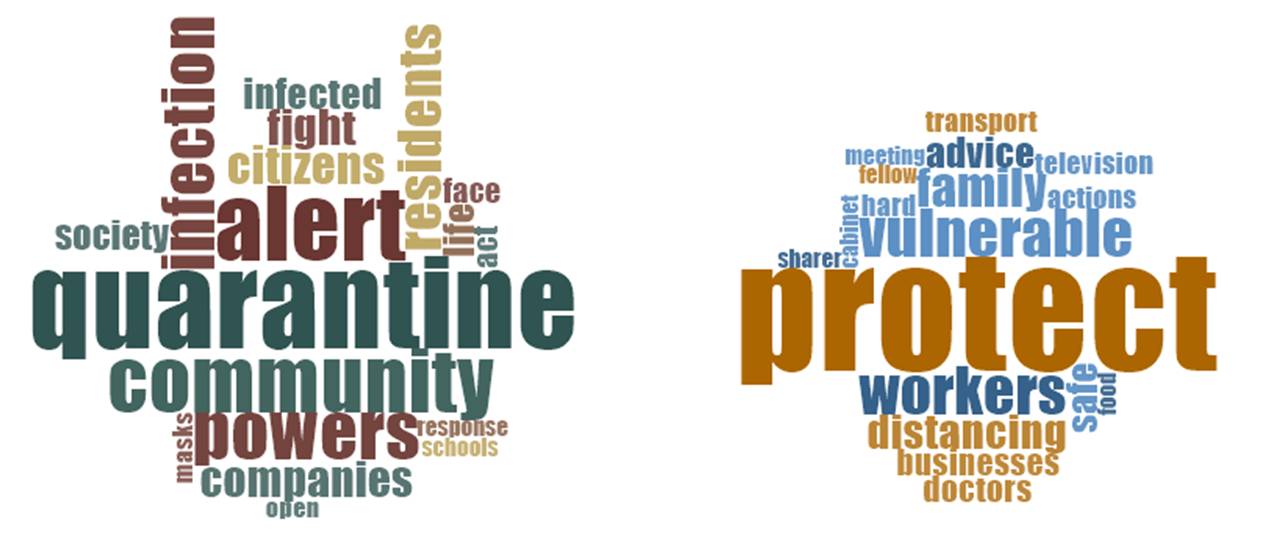In this article we analyse early COVID-19 speeches given by national leaders to consider if female and male leaders differed in the way they communicated crisis. To ensure comparison across leaders of similar countries, we match women-led countries with men-led ones using a range of socio-economic variables. Female leaders were more urgent in highlighting the crisis but also empowering in indicating what citizens can do. Male leaders tended to focus on the role of government in protecting citizens.
Introduction
Since the start of the COVID-19 pandemic, women leaders have been praised for the way they communicated with their citizens. Jacinda Ardern’s use of Facebook live, Angela Merkel’s intuitive explanation of the concept ‘R’ and Erna Solberg talking to children have all been quoted frequently. In this article, we consider whether female leaders were ‘really’ different in the way they communicated the pandemic to their citizens.
To ensure that we compared leaders from similar countries, we matched women-led countries with men-led ones using a range of socio-economic variables (as in (1)). We then compared the early COVID-19 speeches given by the leaders of these matched countries. We find that women were urgent in highlighting the dangers associated with the virus, but were also empowering by indicating what citizens should do themselves. Men tended to use language that emphasised protection and vulnerability, which might have left individuals feeling that “the government will sort things out”.
Matching Women and Men-led Countries
We began with a sample of 20 countries that were led by women during the initial months of the pandemic. We then matched them in terms of economic size and demographic variables (population, population density and population over 65), which are all factors that influence the transmission of the virus, using the nearest neighbour matching technique. Taking these matched pairings as our final sample, we collated public speeches on COVID-19 given by the leaders of these countries between 15th February and 15th April 2020. We found a total of 48 speeches by women and 42 speeches by men. We selected 3 speeches for each leader – one given before lockdown, one announcing lockdown and one post-lockdown. However, not all leaders gave these three speeches. We therefore ensured that we had the same number of speeches for each matched pairing and this gave us a total of 17 speeches by women and 17 by men. Non-English speeches were translated using Google translate.
The speeches were coded in NVivo, a qualitative data analysis software, and we followed a strict protocol to minimise subjectivity. One author coded the speeches and a second moderated the codes. The third author provided additional moderation.
Communicating Crisis to Citizens
We began the speech analyses by examining the frequency and prominence with which leaders communicated crisis to their citizens. Scanning the speeches specifically for evidence of leaders highlighting the urgency of the situation showed that 11 of the 17 (65%) speeches by women leaders made a reference to the urgent situation, while 7 of the 17 (41%) speeches by men made similar references. Women also reinforced their message of urgency by repeating them within the same speech (a repeat rate of 2, compared to the matched male leaders where the average repeat rate was 1.43). In addition to the number of references to urgency, we also found that while women gave shorter speeches than men (on average 662 and 735 words respectively), they used significantly more words in their speeches to convey urgency to their citizens: 55 words per speech as compared to 23 words per speech for men.
An example of these differences can be seen in excerpts taken from speeches by Hong Kong’s Carrie Lam and South Korea’s Moon Jae-in, where both leaders have spoken explicitly about the urgent nature of the pandemic. While Carrie Lam reinforced the message about the urgency of the situation by repeating herself in the same speech, Moon-Jae-in spoke about the urgency in fewer words and without repeated reference to the crisis. Thus, Carrie Lam in a speech on 25th March said, “…as the disease is rapidly spreading overseas, the number of confirmed cases and the speed at which it increases are terrifying. This is a critical moment in the fight against the disease and also a moment for testing the resilience of Hong Kong people in the face of the epidemic”. President Moon Jae-in on 25th February said something similar but in fewer words, “What matters is timing and speed. We must achieve a clear turning point in the ever-increasing number of confirmed cases within this week”.
Gender Differences in Communications
To further analyse these differences, we filtered out common words (examples: and, it, the) and words that were used equally frequently by both women and men leaders (examples: health, people, situation). This allowed us to identify a list of different words that were often used in women and men’s speeches (Figure 1).

These word clouds emphasise the differences in women and men leader’s speeches. Words used by female leaders suggest that they emphasised the emergency of the pandemic (quarantine, alert, infection, life) and how individual and collective action could help the situation (community, citizens, fight, society, act, masks). On the other hand, words used by male leaders emphasised protection and care (protect, vulnerable, family, safe, advice) with the providers and mechanisms of care being more formal (cabinet, doctors, meeting) though the latter did emphasise distancing as well. The word clouds therefore suggest that women were urgent in highlighting the dangers associated with the virus while reinforcing the importance of individual and collective action. Men went into protective and supportive mode, which might have left individuals feeling that the government had control of the situation and would take care of it. The following excerpts from speeches help illustrate this.
President Jeanine Áñez of Bolivia said in a speech on 21st March, “I ask all Bolivian families not to leave their homes, it is a quarantine and you have to take it really seriously”. Similarly, Angela Merkel has said, “Since the Second World War, there has not been a challenge for our country in which action in a spirit of solidarity on our part was so important” (19th March) and Prime Minister Jacinda Ardern (23rd March): “New Zealand is fighting an unprecedented global pandemic and it will take a collective effort of every single New Zealander doing the right thing to give us our best shot at curtailing community outbreak”. On the other hand, as the word cloud indicates, men emphasised protection. Prime Minister Justin Trudeau of Canada said in a speech dated 19th March, “We’re moving fast, because that’s how we will protect Canadians and the economy”. A similar thought was made explicit by President Macron of France, who said, “…everything will be done to protect our employees and to protect our companies at all costs” (12th March). Again, Prime Minister Leo Varadkar of Ireland promised that, “we would do all that we could do to protect the health of our citizens” (27th March).
Both our quantitative and qualitative analysis of the speeches suggest that women leaders were much more urgent in communicating the crisis of the pandemic to their citizens. Further, they encouraged their citizens to play their part in containing the virus, whereas men, even when highlighting the urgency of the situation, were less emphatic about this message and focussed more on the role of their government in protecting citizens. This suggests that, in a crisis, women tend to empower and encourage collective action, whereas men seek to protect and support.
Supriya Garikipati, Uma Kambhampati and Abhilash Kondraganti
References:
- Garikipati, S. and U., Kambhampati, “Leading the fight against the pandemic: Does gender ‘really’ matter?”, Feminist Economist, 27(1-2): 401-418, 2021.



